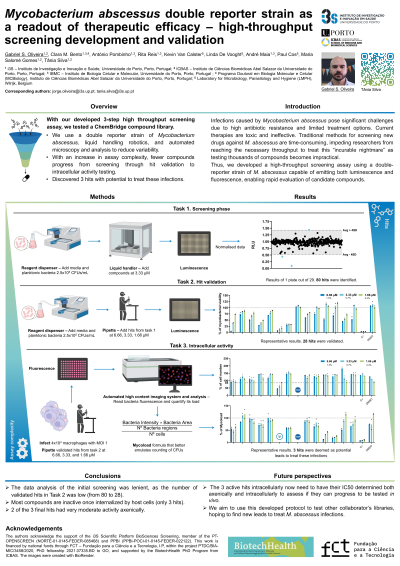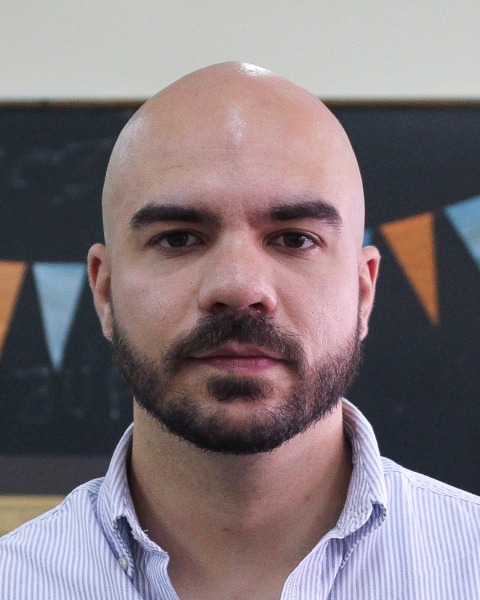Screening Applications & Diagnostics
Poster Session A
(1048-A) Mycobacterium abscessus double reporter strain as a readout of therapeutic efficacy – high-throughput screening development and validation
Tuesday, May 28, 2024
16:30 - 17:15 CEST
Location: Exhibit Hall


Gabriel S. Oliveira
PhD Student
i3S – Instituto de Investigação e Inovação e Saúde, Universidade do Porto, Porto, Portugal
Porto, Porto, Portugal
Poster Presenter(s)
Abstract: Mycobacterial species are characterized by a high intrinsic resistance towards antibiotics. Adding to this, current therapies rely on multi-drug regimens with high toxicity, leading to low patient compliance and low cure rates. The prevalence of nontuberculous mycobacteria is significantly increasing worldwide, and infections caused by Mycobacterium abscessus are the most difficult to treat, comparable to multidrug-resistant tuberculosis, with no approved drugs for its specific treatment. Consequently, the scientific community is now urged to identify new and effective drugs to treat these infections.
To this end, one of the employed strategies is drug repurposing – the process of identifying new therapeutic opportunities for existing compounds in the market, taking advantage of their already established pharmacokinetic and safety profiles. This allows to bypass the major impairment to drug development – the time necessary for the drug to go from bench to bedside.
With most studies that focus on drug development against M. abscessus relying on traditional and time-consuming methods (e.g., CFU), screening thousands of compounds in parallel becomes impractical. Thus, we set out to develop a new assay for high-throughput drug screening against mycobacteria, using an in-house developed double-reporter strain of M. abscessus capable of emitting both luminescence and fluorescence intrinsically. This means that we can take advantage of these intrinsic properties as a readout of therapeutic efficacy without adding any reagents or performing extra steps. Using liquid-handling robotics, automated microscopy and analysis, alongside our double reporter strains, we can quickly measure the viability of bacteria either growing planktonically or internalized by macrophages, being closer to in vivo conditions. Since there is no need to add reagents or perform any extra steps, time and variability between assays are reduced – a major advantage for high-throughput screening assays.
To validate our protocol, we screened a library of 1280 compounds designed for drug repurposing, from Prestwick Chemical libraries®. The available literature confirmed all our findings, thus validating our established assay. With this work, we fulfilled our aim of supplying the field with a new tool to help fight these challenging mycobacteria.
We are now using this assay to test larger libraries with thousands of compounds that are either new small molecules or drugs intended for repurposing, aiming to find new compounds to help treat these infections.
This work was financed by Portuguese national funds through FCT – Fundação para a Ciência e a Tecnologia, within the project PTDC/BIA-MIC/3458/2020 and PhD fellowship 2021.07335.BD to Gabriel S. Oliveira.
To this end, one of the employed strategies is drug repurposing – the process of identifying new therapeutic opportunities for existing compounds in the market, taking advantage of their already established pharmacokinetic and safety profiles. This allows to bypass the major impairment to drug development – the time necessary for the drug to go from bench to bedside.
With most studies that focus on drug development against M. abscessus relying on traditional and time-consuming methods (e.g., CFU), screening thousands of compounds in parallel becomes impractical. Thus, we set out to develop a new assay for high-throughput drug screening against mycobacteria, using an in-house developed double-reporter strain of M. abscessus capable of emitting both luminescence and fluorescence intrinsically. This means that we can take advantage of these intrinsic properties as a readout of therapeutic efficacy without adding any reagents or performing extra steps. Using liquid-handling robotics, automated microscopy and analysis, alongside our double reporter strains, we can quickly measure the viability of bacteria either growing planktonically or internalized by macrophages, being closer to in vivo conditions. Since there is no need to add reagents or perform any extra steps, time and variability between assays are reduced – a major advantage for high-throughput screening assays.
To validate our protocol, we screened a library of 1280 compounds designed for drug repurposing, from Prestwick Chemical libraries®. The available literature confirmed all our findings, thus validating our established assay. With this work, we fulfilled our aim of supplying the field with a new tool to help fight these challenging mycobacteria.
We are now using this assay to test larger libraries with thousands of compounds that are either new small molecules or drugs intended for repurposing, aiming to find new compounds to help treat these infections.
This work was financed by Portuguese national funds through FCT – Fundação para a Ciência e a Tecnologia, within the project PTDC/BIA-MIC/3458/2020 and PhD fellowship 2021.07335.BD to Gabriel S. Oliveira.
